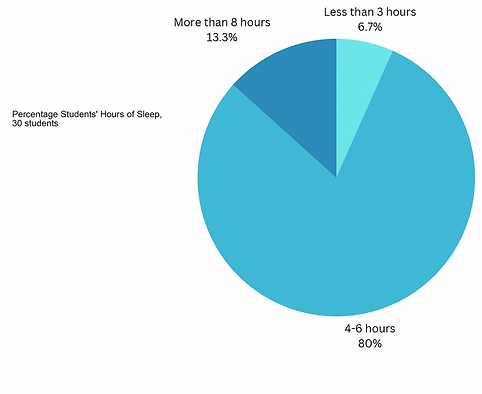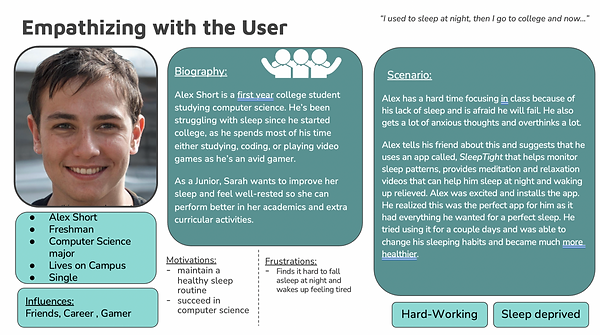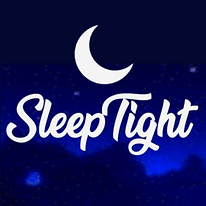Hi, I'm Srinivas Kotha, a UX Designer.
Overview
Problem
My friend shared a common dilemma with me – he struggled to achieve a good night's sleep without the comforting embrace of sounds and music. As a friend and a UX enthusiast, I embarked on a journey to create a solution that would not only accommodate his needs but also enhance his overall sleep quality as a busy college student.
Many college students struggle to catch the quality sleep needed. The stress, late-night assignment grind, involvement in extracurricular activities, and a flood of negative thoughts often leaving students with less than the recommended 8 hours of sleep.
How might we help college students improve their sleep quality and mental well-being while providing a user-friendly interface for tracking and analyzing their sleep patterns?
Inspiration
Sleep Patterns can give you a clear understanding on what is happening during your sleep. The REM cycle plays an important role when it comes to dreaming, memory, and brain development.
While wrist wearables and motion trackers can give you detailed insights on how long you are spending in each sleep cycle, having a headband that measures your brain activity can give you an idea on what is going on in your brain while you sleep.
Goals
How this app will help users:
Ideal for people who are unsure on how to tackle sleep problems and want to understand their sleeping patterns
Ideal for people who meditate before sleeping
Ideal for people who sleep with soothing music or sounds to enhance relaxation and better productivity
User Research
Team
This project was conducted by me. I was in charge of the research and the development of the wireframes and prototype.
Tools
Figma
Timeline
Jan 2023 - May 2023
According to Cornell University, 25% of college students in a survey said lack of sleep affected academic performance negatively while in USF, more than 80% say they are tired and sleepy about 3 days a week. Having good sleep is beneficial for better academic performance.
I have conducted research by interviewing 3 college students and gave 30 students a survey on asking how many hours of sleep they get per day as a college student. I found that 80% of my survey participants get close to 4-6 hours of sleep and their main reason is because of stress, extracurricular activities, and coursework.

I have created two personas to figure out which type of users from my research could be interested in an app like SleepTight.
Competitor Analysis
After I got an idea of the users' unique needs, I tried to understand their user experience in multiple sleeping apps. Not everyone used a sleeping app, but prefer a sleeping app with certain features. I created a competitive analysis and journey map to transform pain points into opportunities of improvement.

User Personas


"I'm so stressed, I'm gonna fail!"
Say
Do
"I can't focus."
"I can't sleep in the night."
Think
Attends college
Studies or codes most of the time
"I want to sleep better, but how? There's so much homework.
Feels tired in class
Feel
Low on energy
Say
"I'm so tired, but I have so much to do."
"I need to pass all my classes."
Do
Active member of the college debate club
Think
"There's so much I have to do, but I am not getting enough sleep. I can't focus in class."
Feel
Feels anxious
Features
How might we help individuals gain insights and optimize their sleeping patterns for improved health and well-being?

The Sleep Tracker captures sleep patterns using various devices like wrist wearables, headbands, or bed attachments. It monitors movement, breathing, heart rate, and disruptions, providing easy-to-understand graphs to track sleep quality.
How might we keep users hooked to the app? How would we interest them in frequently using the app?

Music/Sounds give users set their perfect ambience by music and sounds to match mood, improve sleep, boost focus, and create a relaxing atmosphere. Multiple sounds can be mixed to create a unique blend. Users can easily search and add new favorites to library.

Guided meditations led by experts for stress relief, sleep, focus, and more help users dive into calmness. Set your own pace with our meditation timer and track your progress. Join a supportive community of like-minded meditators.

Filtered Search helps customize your experience by refining search results to match your preferences. Discover sounds, meditation videos, relaxation techniques, and more. Find new friends, get personalized recommendations, and dive into new content—all in one place.
Lo-Fi Wireframes

Designing
The goal of this app is to guide users towards restful nights which is how I got the name, SleepTight meaning: sleep well.
"Sleep tight" is a phrase to wish someone a good night's sleep, a night of peaceful and undisturbed sleep.
I wanted the app's brand personality to be calm, relaxing, simple, & approachable. I wanted to provide reliable support on the path to better sleep, striving to create a soothing experience for users.
Color Palette

Font

App Logo

The Roboto font has a lot of round edges. Fonts with round edges are used to convey calmness, softness, and comfort making it friendly and inviting. Since SleepTight's goal is to help people get better sleep in a calming, friendly manner, Roboto seemed to be the perfect font.I decided to go with dark mode as it reduces blue light and relieves eye strain. It is also an effective option for better quality of sleep. Some people who use dark mode also says that it helps them sleep faster and is easier to read text.
I decided to go with a blue palette because according to LinkedIn, it is associated with positive feelings, loyalty, trust, and has a calming effect to the mind. Studies show that blue and green light helps us wake up in the morning, but darker blue is good for the night and also helps you sleep.
Reflection
My approach for solving this problem was the classic UX journey: UX Research through interviews and surveys, personas, competitive analysis, low fidelity and high fidelity frames, prototype, and feature finalization.
My biggest challenge was figuring out if the sleep tracker idea would work where users can check detailed insights of their sleep patterns and how the app will do it.
First I thought wrist wearables would help get the detailed insights. This was my Senior Capstone Project and my professor told me that I can also think about headbands and eye masks that have bluetooth compatibility.
After sharing my mockups and features with my friends, my classmates, and my professor, everyone loved the music, guided meditations, and insights into sleep patterns. My teacher also found the detailed sleep insights fascinating.
I believe what worked well in my project was my visual design style, its aesthetic appeal with the color palette I have used to create SleepTight.
Couple things I will add in the future include features such as bedtime stories for children and podcasts as I will change the age requirement to all ages. Users will enter their age when they create a new account by putting their birthday. Another feature I would add is incorporate conversational AI to generate personalized monaural beats that can help users fall asleep faster, an AI chatbot, selecting meditation modules for time, and mental health programs.
Right now, I wanted to focus on college students for this Capstone. I received valuable feedback from my classmates, my friends, family, the UX Club of UT Dallas, and teachers on the visual appeal of the app, the features, and the progress of the app.
